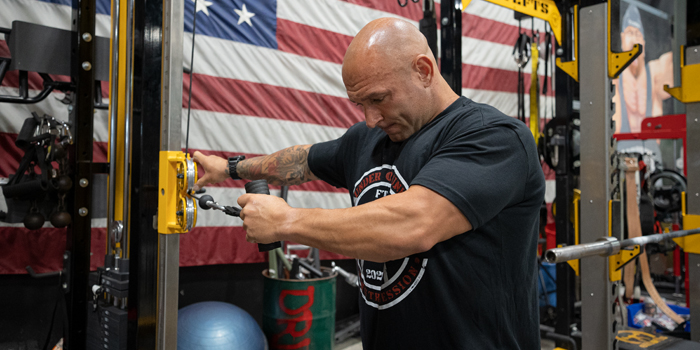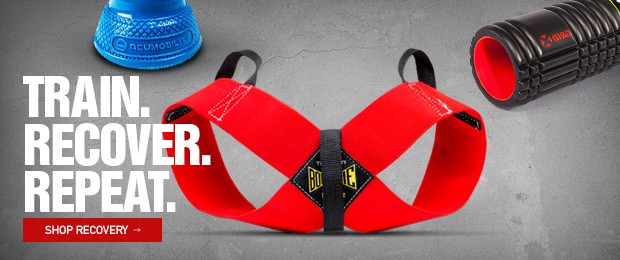
When looking to blend training and physical therapy, there are several components to consider, depending on the problem at hand and why an injury occurred:
- Tissue tolerance
- Pattern development/integration
- Static endurance
- Dynamic stability/tolerance
One of the things I’m best at (after having to learn how to do it for myself more times than I’d care to admit) is to allow training to be rehab and blend the two areas to bridge the gap between traditional physical therapy and training in a way that is productive to both.
I wrote an intro to a case study in a previous article with one of my athletes struggling to return to training when his traditional physical therapy was “too easy.” He couldn’t find carry over into the gym in a way that supported either his goals or his training style.
I started by introducing a movement to address both tissue tolerance and scapular awareness via the idea of coupled motions. I mentioned that one of the things he and I needed to work on next was stability and endurance in a controlled position that actually mattered for training while still allowing direct upper body training.
One of the ways we addressed this was by looking at the functional anatomy of the shoulder blade and upper arm. One of the major tenets of rehabbing most shoulder injuries is shoulder blade control and stability, combined with shoulder joint (ball and socket) stability. We often overlook the functional anatomy of how to blend those together in a pattern that is relevant to the iron sport athlete, rather than throwing a bunch of what feels like piddly physical therapy exercises their way.
Both athletes and clinicians often overlook the details that matter. I’m all about the “take the meat, leave the bone “ mentality, but to stay big picture, we can lose a couple of really simple, low-hanging fruit concepts that can make a big difference. Regarding upper body training and rehab, milking functional anatomy might be what allows progression of both training and rehab simultaneously from the perspective of mechanical tension coupled with postural endurance.
Especially in push sessions or arm sessions, people often forget to really think how the long head of the tricep attaches onto the scapula and should be an involved anchor. One big way you’ll see this principle lost is by shoulder dumping on movements like a tricep extension or losing scapular position and stability on pressing movements.
I filmed a demo video for him (below) of a movement we added to his program as he became increasingly aware of what scapular “control” felt like in a retracted position:
There are a million places we could have started on the cables. Especially given his particular case and goals where he desires both fluidity and rigidity, eventually we’ll need to take him to an overhead position for development, stabilization, and posing. Remember, it’s important not to jump the gun too early. The phrase “the hardest thing you can do well” is one I picked up somewhere and can’t remember where, but it really applies even when the intent of execution is the actual goal.
Main Keys
Maintain Ribcage Control
A flat ribcage makes it tough to allow scapular congruence and control. I probably could have started him in a half-kneeling position to emphasize pillarizing through his core. Still, without majoring in the minors, as long as he’s not accessing increased rib flare/back extension the longer he holds this position, I’m okay with that. As he continues to access those positions, the ribcage flattens out posteriorly, which inherently creates a surface shape (flat) that a shoulder blade (curved bone by nature) has a hard time sitting on. It’s like trying to make a spoon stabilize on a knife rather than spooning.
Maintain Scapular Position
The longer he holds this position, the more difficult it will probably become to maintain scapular control from the mid trap, low trap (for a little posterior tilt), and rhomboids. They're the same muscle groups we targeted a little with the curl example previously written about but in a static (rather than somewhat dynamic) position. From a motor control standpoint, controlling the shoulder blade position while simultaneously asking one of the attached muscles to do something different (like extending the elbow while also helping to stabilize) is much more difficult.
Maintain Shoulder Joint Position
One of the biggest errors I see in performing this exercise is allowing the shoulder joint to “dump ” or shear forward. The shearing pattern in a multitude of upper body training movements (extended range pressing or dips, for example) is often a contributor to why pathology develops. Therefore, it’s important to correct it or at the very least be aware of it consistently.
Maintain Elbow Position
One of the other criteria that makes the exercise challenging is the dual-tasking of the tricep on the shoulder blade while simultaneously extending. Anyone who’s trained triceps and actually seen them develop will tell you how important it is to know when to allow the elbow to move versus when to keep it stable and allow it to be ONLY a pivot point. By maintaining a stationary position and emphasizing zero movement outside pivoting around the axis, you’ll have MUCH better mechanical tension on the tricep itself. You may need to reduce the load, but if mechanical tension is the driver of hypertrophy and you can get it with LESS load needed, there’s a potential for reduced joint strain, with increased benefit. THAT is a win-win for anyone who wants to be around longer than a few years.
Perform initially for reps. Then, transition to a time-under-tension protocol. Eventually, since this is largely a single joint exercise, load will become a limiting factor. Building endurance through a timed protocol can work in conjunction with hypertrophy drivers for metabolic stress.
If you perform this well, the fatigue you start to feel through both the scapular region, rear delt/posterior shoulder, and tricep will be far above what you might expect. Take it up a notch to something like a rear delt-focused mechanical drop set via Joe Bennett’s rear delt destroyer. It will certainly leave you feeling like not only did you improve the pattern that MOST of us need when dealing with a shoulder injury, but you were able to attain a metabolic stress (especially through the rear delts) that should elicit local hormonal responses for hypertrophy.
It's a win-win.
Conclusion
Because of pain and poor overhead patterning, I started him at this cable extension position, where stability is easier to find than overhead. Even his back double bicep posing was a challenge to get into, and overhead pressing (very light) revealed some not-so-great patterning. This indicated that we needed to improve scapular function once we drove stability and integrated other musculature (like serratus). Again, partially for health and partially because anyone who’s been on stage knows how cool serratus looks when you’re up there.
Allowing my client to build with low-hanging fruit in the gym while supplementing with a few other physical therapy exercises I progressed him on allowed him to actually train while bringing up the weak points that prohibited him from moving towards long-term goals.
The next thing we needed to work on in training was improved positioning on the OTHER end of the spectrum in a relatively static environment, then more dynamic transitions. Proprioception and controlling this position are huge. If proprioceptively it’s easiest to feel engagement in either the fully lengthened or fully shortened position, provided load is appropriate, it’s worth exploring letting his training “start” there with low load, moderate to high tension.
His physical therapy work (separate from training) will emphasize scapular control and improved mobility through the mid-range with moderate to low load. When we integrate it in training, we'll see increased force generation, depending on the movement, joints involved, quality of control, and implements available to manipulate the load/strength curve.
One of the biggest things my athletes end up telling me is that “I had no idea such simple changes could have such a big effect on my ability to train and feel like I’m getting more out of less.” Sometimes it really is as simple as being intentional on execution and thoughtful on the progression of very basic exercises.
I’ll continue to detail how we moved him forward.
Dani is a doctor of physical therapy, CSCS, IFBB pro, and an elite-level powerlifter in the 123 class. She's the first to admit she pushes the envelope with training, which uniquely allows her to blend principles of rehab with a love for all things iron. Creativity, relationships, and trust drive her to empower coaches and athletes with tools and education from a PT who understands training demands. She can be reached for remote PT services, consults, and training at Dani@MergePerformancePT.com.










